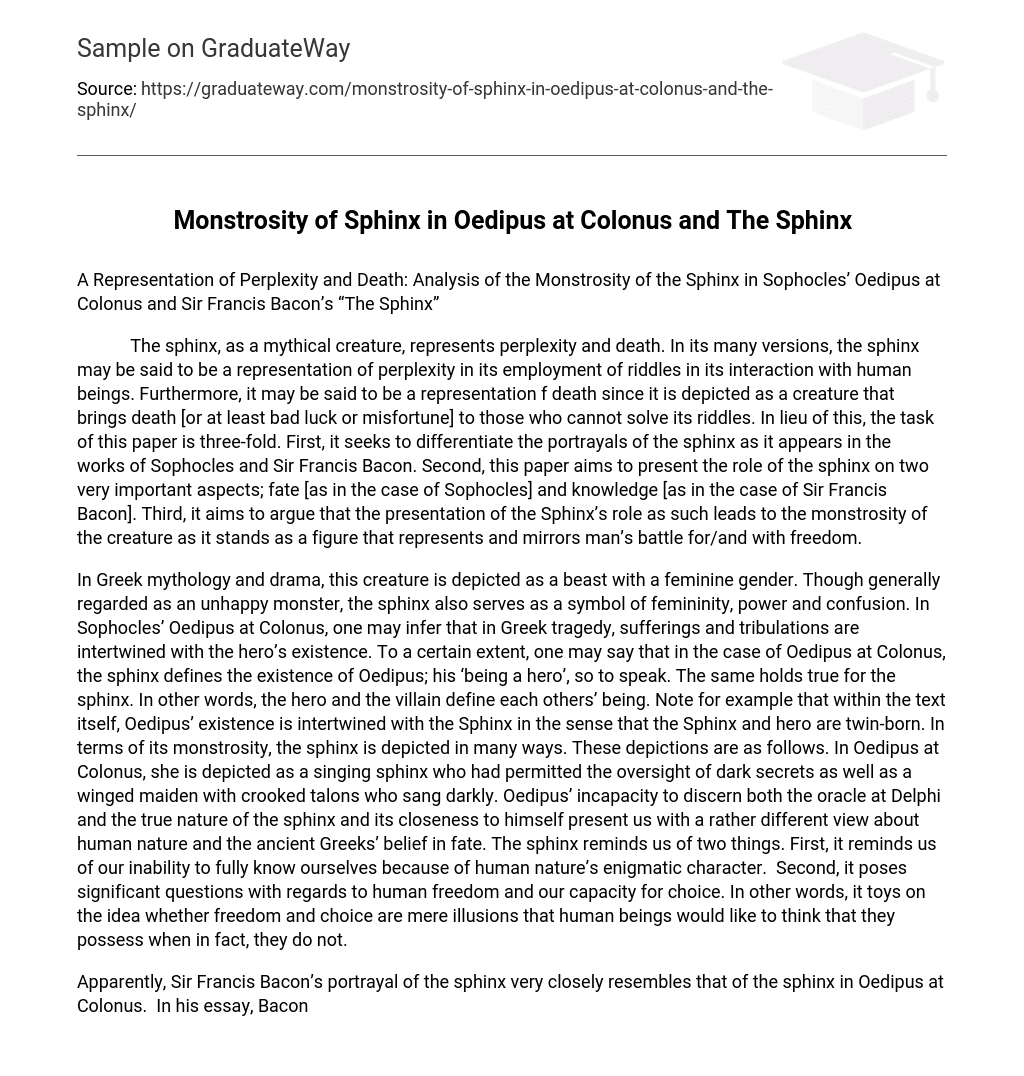A Representation of Perplexity and Death: Analysis of the Monstrosity of the Sphinx in Sophocles’ Oedipus at Colonus and Sir Francis Bacon’s “The Sphinx”
The sphinx, as a mythical creature, represents perplexity and death. In its many versions, the sphinx may be said to be a representation of perplexity in its employment of riddles in its interaction with human beings. Furthermore, it may be said to be a representation f death since it is depicted as a creature that brings death [or at least bad luck or misfortune] to those who cannot solve its riddles. In lieu of this, the task of this paper is three-fold. First, it seeks to differentiate the portrayals of the sphinx as it appears in the works of Sophocles and Sir Francis Bacon. Second, this paper aims to present the role of the sphinx on two very important aspects; fate [as in the case of Sophocles] and knowledge [as in the case of Sir Francis Bacon]. Third, it aims to argue that the presentation of the Sphinx’s role as such leads to the monstrosity of the creature as it stands as a figure that represents and mirrors man’s battle for/and with freedom.
In Greek mythology and drama, this creature is depicted as a beast with a feminine gender. Though generally regarded as an unhappy monster, the sphinx also serves as a symbol of femininity, power and confusion. In Sophocles’ Oedipus at Colonus, one may infer that in Greek tragedy, sufferings and tribulations are intertwined with the hero’s existence. To a certain extent, one may say that in the case of Oedipus at Colonus, the sphinx defines the existence of Oedipus; his ‘being a hero’, so to speak. The same holds true for the sphinx. In other words, the hero and the villain define each others’ being. Note for example that within the text itself, Oedipus’ existence is intertwined with the Sphinx in the sense that the Sphinx and hero are twin-born. In terms of its monstrosity, the sphinx is depicted in many ways. These depictions are as follows. In Oedipus at Colonus, she is depicted as a singing sphinx who had permitted the oversight of dark secrets as well as a winged maiden with crooked talons who sang darkly. Oedipus’ incapacity to discern both the oracle at Delphi and the true nature of the sphinx and its closeness to himself present us with a rather different view about human nature and the ancient Greeks’ belief in fate. The sphinx reminds us of two things. First, it reminds us of our inability to fully know ourselves because of human nature’s enigmatic character. Second, it poses significant questions with regards to human freedom and our capacity for choice. In other words, it toys on the idea whether freedom and choice are mere illusions that human beings would like to think that they possess when in fact, they do not.
Apparently, Sir Francis Bacon’s portrayal of the sphinx very closely resembles that of the sphinx in Oedipus at Colonus. In his essay, Bacon describes the sphinx as a “monster combining many shapes in one” (343). In addition to this, the sphinx “had the face and voice of a virgin, the wings of a bird and the claws of a griffin” (Bacon 343). In Bacon’s essay, as in Sophocles’ story, the sphinx may still be said to resemble death and perplexity. The sphinx still waits for its prey and asks riddles and “if the wretched captives could not at once solve and interpret the same, as they stood hesitating and confused she tore them to pieces” (Bacon 343). This cruelty, on the part of the sphinx, is similar in both Sophocles and Bacon’s works. This is precisely because Bacon’s sphinx is modeled after Sophocles’ sphinx in the Oedipus trilogy, of which, Oedipus at Colonus is a part of.
Although the descriptions of the physical features of the sphinx and its apparent cruelty in both Sophocles and Sir Francis Bacon’s works are to a certain extent similar, it is, however, important to note that the riddles of the sphinx are directed at different things. One may infer that these two works resonate two different themes. The ancient Greeks believe in fate or destiny and one of Sophocles’ themes in the Oedipus Trilogy is whether or not, human beings can escape their fate or destiny. Sophocles employs the sphinx, a mythical beast, and its riddles, with the intention of bringing forth perplexity among human beings and allows introspection about the deepest questions concerning fate r destiny, human nature and the quest for self-knowledge. Sir Francis Bacon’s theme, on the other hand, is more concerned with what may be called knowledge in the scientific sense of the term.
Such being the case, his employment of the sphinx in his essay naturally differs from Sophocles’. To a certain extent, Sir Francis Bacon’s sphinx is still a representation of death and perplexity but it must be noted that death and perplexity, are in this case, different from Sophocles’. From a scientific standpoint, the acquisition of knowledge is crucial for human survival. Ignorance may very well spell doom for our species. This is what may be called as the practical value of knowledge and of knowing. This necessity also partly explains why human beings become uneasy when they do not know. In this sense, the question of the sphinx’s monstrosity in comparison to human beings [as depicted by Oedipus for example] may be equated with the monstrosity involved in the human experience with the battle with freedom as well as human being’s battle against ignorance.
Work Cited
Bacon, Sir Francis. “The Sphinx”. Forbidden Knowledge. New York: Harcourt Brace, 1997.
Sophocles. Oedipus at Colonus. Trans. George Young. London: Dover, 1999.





